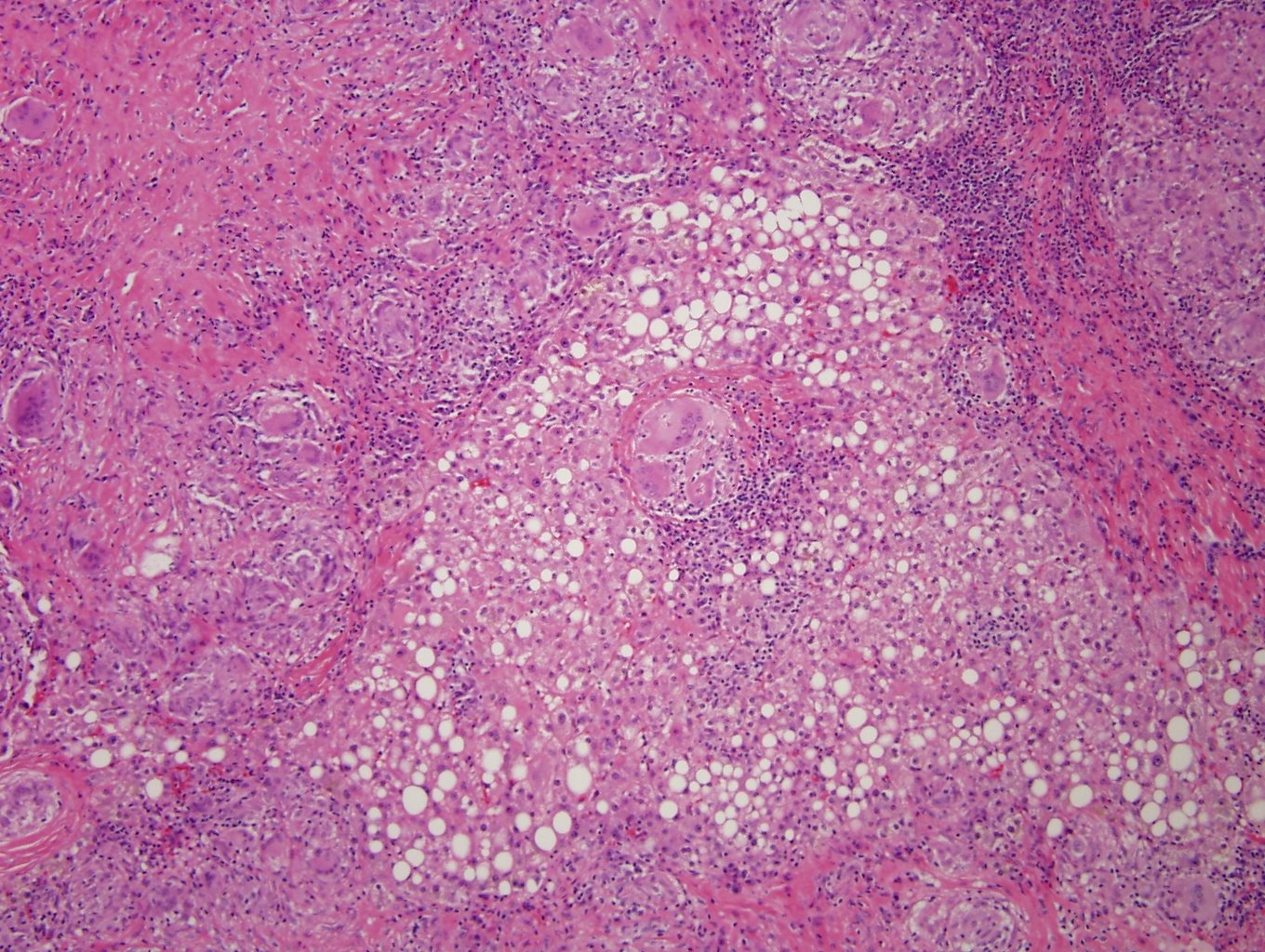Back


Poster Session C - Monday Afternoon
Category: Liver
C0606 - Hepatic Sarcoidosis Presenting as Cholestatic Liver Injury Exacerbated by Nitrofurantoin Use
Monday, October 24, 2022
3:00 PM – 5:00 PM ET
Location: Crown Ballroom

Has Audio

Sean Halloran, BS
University of Toledo College of Medicine and Life Sciences
Toledo, OH
Presenting Author(s)
Sean Halloran, BS1, Sara Stanley, DO2, Jordan Burlen, MD3, Yaseen Alastal, MD, MPH2
1University of Toledo College of Medicine and Life Sciences, Toledo, OH; 2University of Toledo, Toledo, OH; 3The Ohio State University, Toledo, OH
Introduction: The liver is a common site of involvement in patients with sarcoidosis with 50-80% of patients having hepatic involvement at initial diagnosis. However, it is largely asymptomatic and less than 15% of patients present with symptoms of significant hepatic injury. We report a patient with hepatic sarcoidosis presenting as cholestatic liver injury exacerbated by nitrofurantoin use.
Case Description/Methods: A 67-year-old African American female presented due to 1 week of diffuse itching, shortness of breath, and scleral icterus with darkened urine. Medical history was significant for type 2 diabetes, hypertension, and hyperlipidemia without history of liver disease. Patient denied alcohol use and was a lifetime non-smoker. Family history was significant for sarcoidosis in father. Notably, the patient took nitrofurantoin for a urinary tract infection one week prior to presentation. Lab results showed elevated direct bilirubin 5.2, total bilirubin 8.8, ALK PHOS 950, ALT 126, and AST 229. Urinalysis was positive for glucose and moderate bilirubin. CT of chest, abdomen and pelvis showed abdominal and mediastinal lymphadenopathy. Ultrasound of the liver and MRCP showed hepatic steatosis and gallbladder sludge without acute cholecystitis or biliary dilation. EUS with FNA of a mediastinal lymph node displayed numerous granulomas. Liver biopsy showed cholestatic granulomatous hepatitis with stage 2-3 bridging fibrosis. Biopsy was negative for A1AT, acid-fast bacilli, and fungal organisms. ANA, AMA, SMA, and hepatitis panel were negative. This patient’s presentation was deemed most consistent with hepatic sarcoidosis and prednisone therapy was initiated. The patient reports improvements in pruritus and scleral icterus. Nitrofurantoin is a well-known cause of hepatic injury, but has rarely been reported as causing granulomatous disease exacerbating underlying sarcoidosis.
Discussion: While the liver is a common site of involvement in patients with sarcoidosis, the vast majority of patients are asymptomatic and do not require treatment. Hepatotoxic drugs can exacerbate the symptoms of hepatic sarcoidosis and lead to clinical diagnosis. In those with clinical symptoms, a cholestatic pattern is most common. Glucocorticoids and antimetabolites such as methotrexate are commonly used treatments. However, there is a lack of large randomized controlled studies regarding the treatment and surveillance of hepatic sarcoidosis at this time.

Disclosures:
Sean Halloran, BS1, Sara Stanley, DO2, Jordan Burlen, MD3, Yaseen Alastal, MD, MPH2. C0606 - Hepatic Sarcoidosis Presenting as Cholestatic Liver Injury Exacerbated by Nitrofurantoin Use, ACG 2022 Annual Scientific Meeting Abstracts. Charlotte, NC: American College of Gastroenterology.
1University of Toledo College of Medicine and Life Sciences, Toledo, OH; 2University of Toledo, Toledo, OH; 3The Ohio State University, Toledo, OH
Introduction: The liver is a common site of involvement in patients with sarcoidosis with 50-80% of patients having hepatic involvement at initial diagnosis. However, it is largely asymptomatic and less than 15% of patients present with symptoms of significant hepatic injury. We report a patient with hepatic sarcoidosis presenting as cholestatic liver injury exacerbated by nitrofurantoin use.
Case Description/Methods: A 67-year-old African American female presented due to 1 week of diffuse itching, shortness of breath, and scleral icterus with darkened urine. Medical history was significant for type 2 diabetes, hypertension, and hyperlipidemia without history of liver disease. Patient denied alcohol use and was a lifetime non-smoker. Family history was significant for sarcoidosis in father. Notably, the patient took nitrofurantoin for a urinary tract infection one week prior to presentation. Lab results showed elevated direct bilirubin 5.2, total bilirubin 8.8, ALK PHOS 950, ALT 126, and AST 229. Urinalysis was positive for glucose and moderate bilirubin. CT of chest, abdomen and pelvis showed abdominal and mediastinal lymphadenopathy. Ultrasound of the liver and MRCP showed hepatic steatosis and gallbladder sludge without acute cholecystitis or biliary dilation. EUS with FNA of a mediastinal lymph node displayed numerous granulomas. Liver biopsy showed cholestatic granulomatous hepatitis with stage 2-3 bridging fibrosis. Biopsy was negative for A1AT, acid-fast bacilli, and fungal organisms. ANA, AMA, SMA, and hepatitis panel were negative. This patient’s presentation was deemed most consistent with hepatic sarcoidosis and prednisone therapy was initiated. The patient reports improvements in pruritus and scleral icterus. Nitrofurantoin is a well-known cause of hepatic injury, but has rarely been reported as causing granulomatous disease exacerbating underlying sarcoidosis.
Discussion: While the liver is a common site of involvement in patients with sarcoidosis, the vast majority of patients are asymptomatic and do not require treatment. Hepatotoxic drugs can exacerbate the symptoms of hepatic sarcoidosis and lead to clinical diagnosis. In those with clinical symptoms, a cholestatic pattern is most common. Glucocorticoids and antimetabolites such as methotrexate are commonly used treatments. However, there is a lack of large randomized controlled studies regarding the treatment and surveillance of hepatic sarcoidosis at this time.

Figure: Histology slide showing hepatic involvement of sarcoidosis.
Disclosures:
Sean Halloran indicated no relevant financial relationships.
Sara Stanley indicated no relevant financial relationships.
Jordan Burlen indicated no relevant financial relationships.
Yaseen Alastal indicated no relevant financial relationships.
Sean Halloran, BS1, Sara Stanley, DO2, Jordan Burlen, MD3, Yaseen Alastal, MD, MPH2. C0606 - Hepatic Sarcoidosis Presenting as Cholestatic Liver Injury Exacerbated by Nitrofurantoin Use, ACG 2022 Annual Scientific Meeting Abstracts. Charlotte, NC: American College of Gastroenterology.
